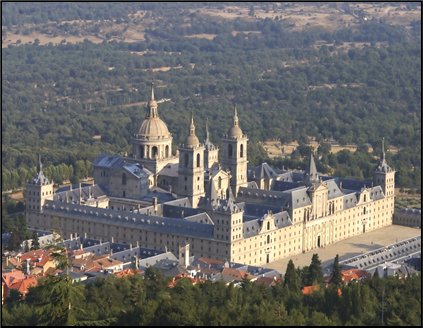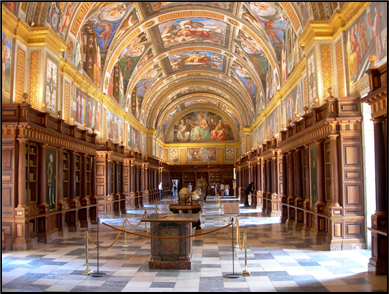


xxxxxThe massive royal palace-
THE ESCORIAL PALACE-
 xxxxxThe royal monastery of El Escorial is one of the largest religious establishments in the world, covering an area about 206 by 160 metres. It was built by Philip II to provide a burial place for all Spanish sovereigns. First to be buried there was his father, Emperor Charles V, and since that time all but three monarchs have been interred within its walls. Workxon this ambitious project -
xxxxxThe royal monastery of El Escorial is one of the largest religious establishments in the world, covering an area about 206 by 160 metres. It was built by Philip II to provide a burial place for all Spanish sovereigns. First to be buried there was his father, Emperor Charles V, and since that time all but three monarchs have been interred within its walls. Workxon this ambitious project -
xxxxxBautista was responsible for the overall plan of the monastery, and this consisted of a huge rectangle with the church in the centre, the monks' living quarters in the north, and the royal palace and administrative offices to the south. Herrera made amendments to these original plans, adding an extension to the west facade, and improving the design of the church, which, when completed, was an impressive building with two bell towers and a large central dome. The complex, four storeys in height and with towers at each corner, was completed in 1584. A college and library were added later.
 xxxxxAlthough both architects had worked or lived in Italy, the influence of the High Renaissance is somewhat limited, due to what came to be known as the "Herreran style". Clearly restricted by the king's desire to avoid ornamentation, this style produced a monumental building with thick, grey granite walls, virtually devoid of decoration and providing an exterior which was both grim and forbidding. In stark contrast to Charles V's luxurious, ornate palace within the Alhambra, this imposing building was not without its critics, but this severe, majestic style was doubtless meant to express the imperial Spain of the day. As such, it was to prevail in the design of churches and palaces over the next fifty years or so, and to find its way to the New World. Today, the Escorial is regarded as one of the finest architectural monuments in Europe.
xxxxxAlthough both architects had worked or lived in Italy, the influence of the High Renaissance is somewhat limited, due to what came to be known as the "Herreran style". Clearly restricted by the king's desire to avoid ornamentation, this style produced a monumental building with thick, grey granite walls, virtually devoid of decoration and providing an exterior which was both grim and forbidding. In stark contrast to Charles V's luxurious, ornate palace within the Alhambra, this imposing building was not without its critics, but this severe, majestic style was doubtless meant to express the imperial Spain of the day. As such, it was to prevail in the design of churches and palaces over the next fifty years or so, and to find its way to the New World. Today, the Escorial is regarded as one of the finest architectural monuments in Europe.
 xxxxxWithin the complex Philip II founded a large, imposing library (illustrated), containing a rare collection of some 4,700 manuscripts, many superbly illuminated, and 40,000 printed books.
xxxxxWithin the complex Philip II founded a large, imposing library (illustrated), containing a rare collection of some 4,700 manuscripts, many superbly illuminated, and 40,000 printed books.
xxxxxIncidentally, the Greek-
Acknowledgements
Escorial: date and photographer unknown – Tourist Board, Madrid, Spain. Fortress: date and photographer unknown. Library: date and photographer unknown – use unrestricted.
L1-


